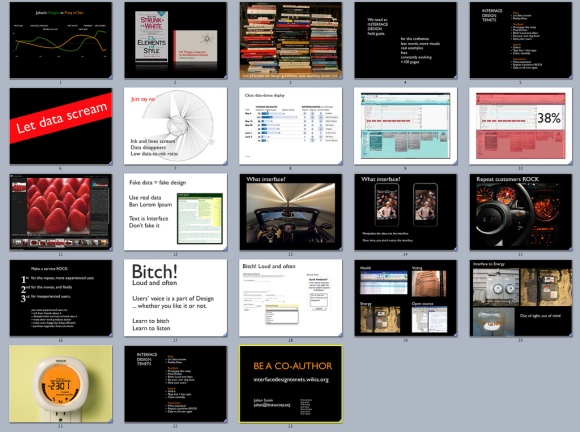(Source)
This week, my students will be organizing, designing, and delivering their Ignite presentations. Ignite is a speedy, fixed-format presentation similar to PechaKucha. The differences between the structure of the two types are minimal. PechaKucha was envisioned by Astrid Kline and Mark Dytham, two designers working in Japan, as a way for artists and designers to share their ideas. The basic stipulation of a PK is that it be 20 slides, each timed to automatically move forward after 20 seconds for a total of six minutes, 40 seconds. PK has grown to become a worldwide phenomenon. I had the pleasure of presenting at PechaKucha Night Orlando vol. 2 and the experience changed how I think about and approach presentations. Ignite was developed by O’Reilly Media and is dubbed the “nerd” presentation. Ignite topics tend to be less artistic and more scientific. Ignite’s only stipulation is 20 slides, each timed to automatically move forward after 15 seconds for a total of five minutes. While Ignite is not as prolific as PechaKucha, it is also performed in over 100 cities worldwide.
Ignites are characterized by three important qualities:
1. Ignites are story-driven
(Source)
The best Ignites are structured as stories, the story of how the presenter recovered from a concussion by making it a game, as in the case of Jane McGonigal’s the concussion slayer.
2. Ignites are original
(Source)
Just like PechaKucha, it is more important for an Ignite presentation to be utterly original and unique in focus. There are no “legalize marijuana” Ignites. Sorry, that’s played out! Instead, presenters talk about a range of topics from flash mobs and giraffe pics to how to use cartoons to get 5 million views on your website from my favorite, Matt Inman of The Oatmeal.
3. Ignites are the purest version of your idea
With only five minutes to get a point across, an Ignite challenges presenters to weed out tangential elements and get to the point. This is a fantastically challenging exercise for my students–what really matters to your topic? What’s going to plant that seed of change in your audience?
When Alex Rister and I revised the course structure for Professional Communication and Presentation, we made the decision to switch to the Ignite model. Five minutes is a nice round number, was more manageable for larger classes, and also forces presenters to truly enlighten their audiences, but make it quick (Ignite’s mantra). For a brief introduction to Ignite, check out Alex’s article, “What is an Ignite and why you should try it” as well as the official Ignite site.
In the past few months, two students have provided me with invaluable assets related to the subject of putting together a strong Ignite presentation. I’ve shared one of them above in my new favorite Ignite example, “How to Buy a Car” by Rob Gruhl (man, do I wish I’d watched this before buying my first car…). The second is an excellent guide to an Ignite by Scott Berkun, author of such excellent books as Confessions of a Public Speaker, an irreverent guide to what public speakers actually do/think. In this article, Berkun shares tips to giving a great Ignite, including an Ignite on how to give an Ignite (LOVE!).
My favorite takeaways from Berkun’s article are:
Figure out your points before you make slides
(Source)
Nothing makes me cringe like a student who’s already built 15 slides for a presentation he’s done no audience analysis and analog planning on first. Preparation matters more than sweet slides. Again and for the one billionth time from someone who is pigeon holed by students and faculty alike as “the girl who hates bullet points”, content matters more than slides! As Berkun says, “you’ll quickly discover how unlikely it is to run out of things to say during an ignite talk. Once you know the 4 major points you want to make, only then work on finding images and slides to support what you’re going to say.”
Make your talk fault tolerant
My students biggest source of anxiety is always what they should do if a slide moves forward while they are still delivering content from the previous slide. This anxiety comes from the perception that this speech is different from every other type of presentation. It’s not. It’s exactly the same–by structuring bridges and transitions between ideas and devoting sections of a presentation to the supporting points of your big idea, you create a structure that is fault-tolerant. So what if you are a bit ahead or behind? Your ideas are all interconnected, so it’s ok if you are wrapping up a point or waiting for audience reaction before moving on to your next idea. Don’t think of an Ignite as 20 separate and disconnected chunks. This is one presentation, one idea. Berkun’s advice is this: …”build your talk into 4 of 5 pieces, where each piece could stand alone. Then if you fall behind, or something goes wrong, when the first slide for the next part comes up, you can easily recover.”
Thank you to Thiet Ngo and Elah Ruth Abi Saab for their excellent links. You’ve given future students some great information to draw from, superstudents!




